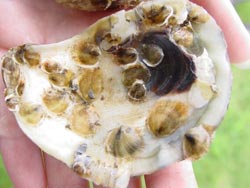The Bay Is His Oyster: Ray Grizzle Is Restoring Oyster Reefs To NH’s Great Bay

In the past decade, the oyster population in New Hampshire’s Great Bay estuary has plummeted by 90 percent, due to the 1995 arrival of the oyster disease MSX. The previous century saw a slower but equally devastating demise of oysters from exuberant overharvesting. “We have seen local extinction on some reefs,” says Ray Grizzle, research associate professor at the University of New Hampshire’s Jackson Estuarine Laboratory.
Now Grizzle is working to bring oysters back to Great Bay – lots of them. He’s helping the state of New Hampshire meet its established goal of restoring 20 acres of oyster reefs by 2010. “I hope we’re going to have a bay with a healthy oyster population, and we’re going to work hard to do it,” he says. His research explores which are the best reef restoration techniques for the Great Bay estuarine system (www.oysters.unh.edu).
Oyster reef restoration involves providing sufficient hard substrate – typically oyster shells on which young oysters settle and grow – and seeding it with disease-resistant young oysters. Natural oyster reefs are formed by live oysters atop mounds of empty shells; one initiative of Grizzle’s lab is soliciting “recycled” empty shells from oyster harvesters that will eventually be returned to the bay to provide substrate.
Grizzle likens his role in oyster reef restoration to an “ecological physician.” Just as an orthopedist can set a broken bone but the body must do the healing, he can set up conditions that are right for oyster reefs to prosper, but factors beyond his control – water quality, larval abundances, and other conditions he’s exploring – play a major role in his success.
At five different restoration sites around the Great Bay estuarine system, Grizzle and his team are experimenting with optimal conditions for reef restoration. One major research question is whether several small or one large reef promote abundance, survival and growth of the larval oysters (called “spat” when they are settled on the reefs). “It’s like sodding your lawn versus sprigging it,” says Grizzle, adding that the smaller reefs seem to show the best results.
Oyster harvesting in the Great Bay estuary system (http://www.oysters.unh.edu/Graphics/great-bay-map.gif) – the only oyster habitat in New Hampshire – is almost exclusively a recreational pursuit, so restoring oyster reefs would have a relatively small impact at the raw bar. However, there are typically several hundred licenses for recreational harvesting issued each year by the New Hampshire Fish and Game Department. Also, the effect on water quality could be significant: Each oyster, says Grizzle, pumps 20 or so gallons of water each day through them, retaining particles as small as a virus. “They’re marvelous filters,” he says.
Further, he notes that oyster reefs, much like seagrass beds or coral reefs, support a variety of marine life. “Oyster reefs provide all these nooks and crannies for other organisms,” he says, including sport fishes. “If we improve the habitat for oysters we can improve the environment.”
Funding sources for Grizzle’s oyster reef restoration work include the National Oceanic and Atmospheric Administration, the New Hampshire Estuaries Project, The Nature Conservancy, the City of Dover (N.H.), N.H. Sea Grant, and the Natural Resources Conservation Service.
Media Contact
All latest news from the category: Ecology, The Environment and Conservation
This complex theme deals primarily with interactions between organisms and the environmental factors that impact them, but to a greater extent between individual inanimate environmental factors.
innovations-report offers informative reports and articles on topics such as climate protection, landscape conservation, ecological systems, wildlife and nature parks and ecosystem efficiency and balance.
Newest articles

Properties of new materials for microchips
… can now be measured well. Reseachers of Delft University of Technology demonstrated measuring performance properties of ultrathin silicon membranes. Making ever smaller and more powerful chips requires new ultrathin…

Floating solar’s potential
… to support sustainable development by addressing climate, water, and energy goals holistically. A new study published this week in Nature Energy raises the potential for floating solar photovoltaics (FPV)…

Skyrmions move at record speeds
… a step towards the computing of the future. An international research team led by scientists from the CNRS1 has discovered that the magnetic nanobubbles2 known as skyrmions can be…





















